Cheval Blanc 2020 was one of the first key releases out of the gate for this year’s Bordeaux en primeur campaign yesterday.
Having tasted in Bordeaux last week, Wine Lister’s CEO, Ella Lister, hails the wine “restrained and profound” on the nose, with “dark, hypnotic fruit”. The palate, she says, is “straight-lined, mineral, mouth-watering and fresh”, with an “incredibly long, saline finish”. As one of her favourite wines of the vintage, she would potentially give it a perfect score.
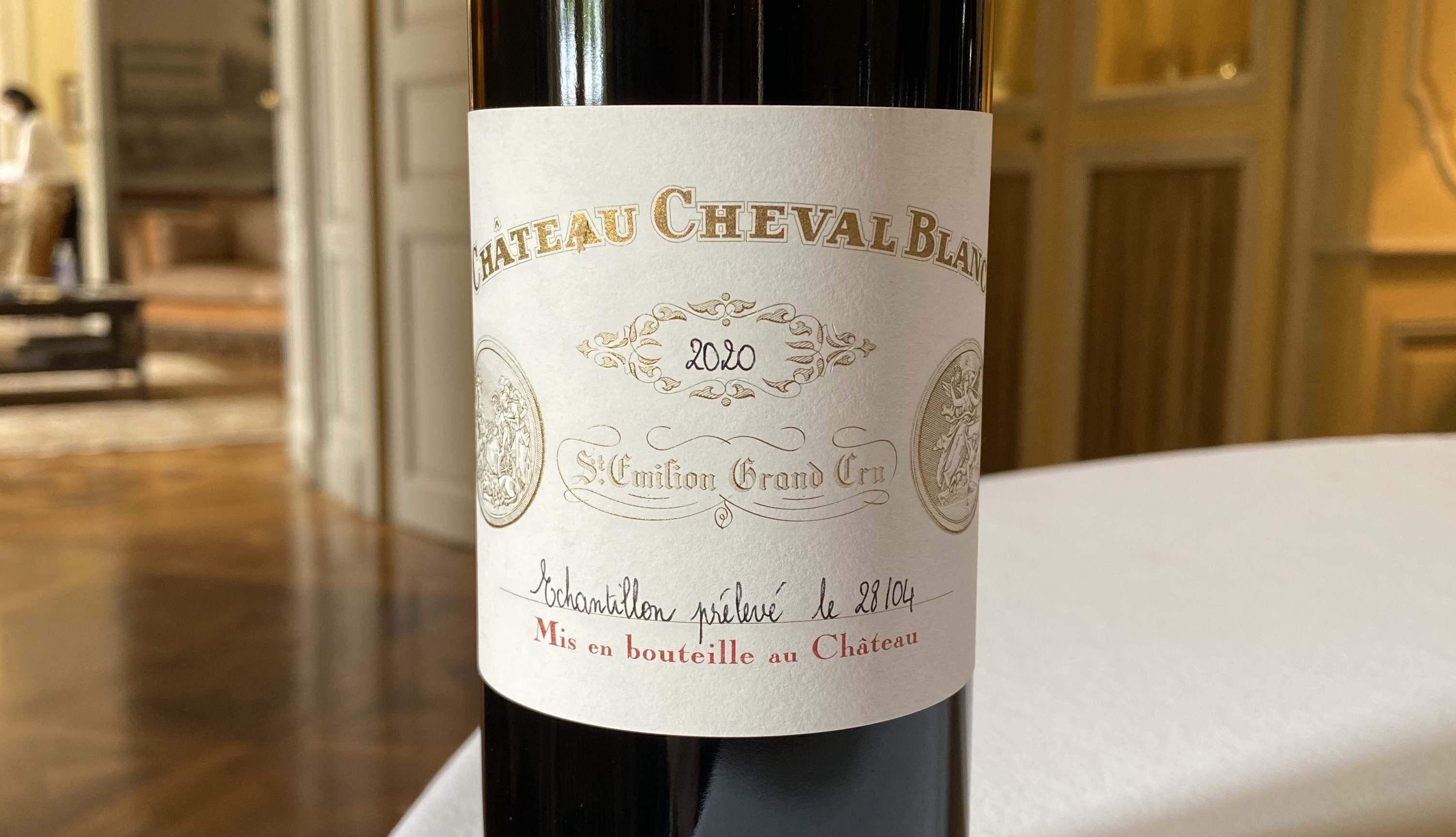
Technical Director, Pierre-Olivier Clouet notes that 2020 is cut quite differently from recent years at the estate. He characterises the vintage at Cheval Blanc in “three major waves”. First, the humid spring encouraged the vines to grow calmly and homogenously, accumulating water and nutrients much needed later in the season. The second wave was one of drought, which Clouet explains gives Cheval Blanc 2020 “a deep, tannic structure – dense but not hard, firm but not dry, ripe but not cooked”. Balancing this is Clouet’s “third wave” – a period of intense heat towards the end of the summer. With temperatures during harvest reaching 38-39 degrees Celsius, the hot spell translates into a very “expressive, intense, crisp, and aromatic nose”, and a freshness on the palate thanks to quick picking, within 20 days (half the usual duration).
Cheval Blanc 2020 was being offered by UK merchants at around £380 per bottle in-bond – 3% above the 2019 release price, but well under the price of any small remaining quantities of 2019 currently available on the British secondary market. Last year’s gesture on pricing was exceptionally well-received, and the 2020 will likely be no exception.
Speaking with some of the region’s top producers, Wine Lister CEO, Ella Lister provides her overview of Bordeaux’s 2020 vintage.
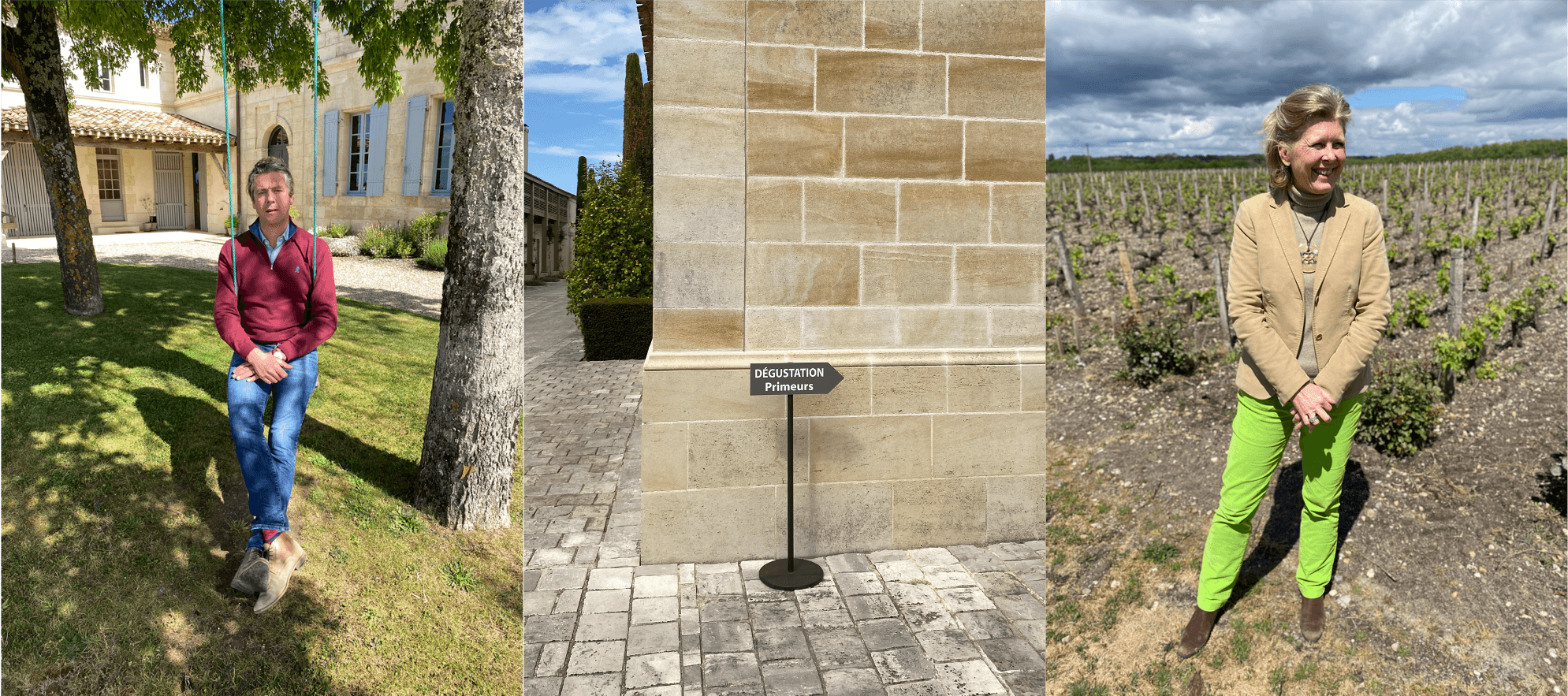 Left: Baptise Guinaudeau of Lafleur and Grand Village / Right: Véronique Sanders of Haut-Bailly and Le Pape
Left: Baptise Guinaudeau of Lafleur and Grand Village / Right: Véronique Sanders of Haut-Bailly and Le Pape
What should we expect from Bordeaux 2020?
2020 is an unprecedented vintage both in terms of the pandemic context and its juxtaposition of tannic power and exquisite freshness. On both banks of Bordeaux, the wines are characterised by an early growing season that underwent a series of extremes: a warmer winter than usual, a rainier spring, and a record dry summer, without so much as a drop of rain from mid-June to mid-August, then finally exceedingly hot during the harvest (one should spare a thought for the masked pickers). In spite of such difficulties, Veronique Sanders of Château Haut-Bailly notes that “the easy vintages in Bordeaux used to be the best ones, but in recent years that’s not the case”.
Henri Lurton, owner of Château Brane-Cantenac in Margaux, referred to 2020 as a “quite unique” vintage, both “hot and classic” at the same time. This observation is echoed by Baptiste Guinaudeau, co-owner of Château Lafleur in Pomerol, who recognises in 2016, 2018, and now 2020, a new type of growing season that didn’t exist before, uniting a big, sunny vintage like 2009 with a more classical vintage like 2008. 2020 is “multiple vintages in a single wine”, according to Lafleur’s cellar master, Omri Ram.
While several wines in 2020 in have record tannic density, you wouldn’t know it without the technical analyses. When you taste the wines, this power hidden by a delicate, diaphanous veil. Acidity remains decently high, and alcohol relatively low, allowing the wines to maintain the classicism that we recognise and love in Bordeaux.
In a year where the Bordelais couldn’t go on their usual marketing trips to the US, China and beyond, they were closer to the vines and to nature. This often meant whole teams dedicated to the vine-growing and winemaking instead of sales and marketing. This often meant whole teams dedicated to the vine-growing and winemaking instead of sales and marketing. “Un vin d’équipe”, says Marielle Cazaux, technical director of La Conseillante, referring to the unprecedented “team effort”, as the office staff worked in the vineyards, helping the vines through extreme rain, then drought, then heat.
Completing a trilogy of excellent vintages, after 2018 et 2019, 2020 is nonetheless more heterogeneous, where the top terroirs were best able to cope with the extreme climatic conditions. Each appellation boasts some exceptional wines, be it Pauillac, Pessac-Léognan or Pomerol. And these wines have a floral freshness, often of peonies or iris (the latter a scent deriving from merlot when it undergoes hydric stress).
Finally, the whites deserve a special mention in 2020. A vintage for lovers of richer, creamier whites, we found the best almost Burgundian, without the varietal grassiness of Sauvignon Blanc.
As Wine Lister enters its fifth year in business, we are excited to announce the addition of 650 new wines onto Wine Lister’s information hub. Thanks to scores from our trusted partner critics, prices through our official pricing partner, Wine Owners, and data measuring popularity, as determined by the number of searches on Wine-Searcher (Pro and Pro+ site only), website users can now discover Wine Lister scores, prices, and apply decision-making analysis tools to a broader range of fine wines. With the latest additions, our database now extends across 4,450 wines, and over 40,000 wine-vintages, providing further insight to inform wine investment choices and strategic solutions.
Below we examine the regional split of the additional wines, and take a closer look at some of the properties featured in the expansion.
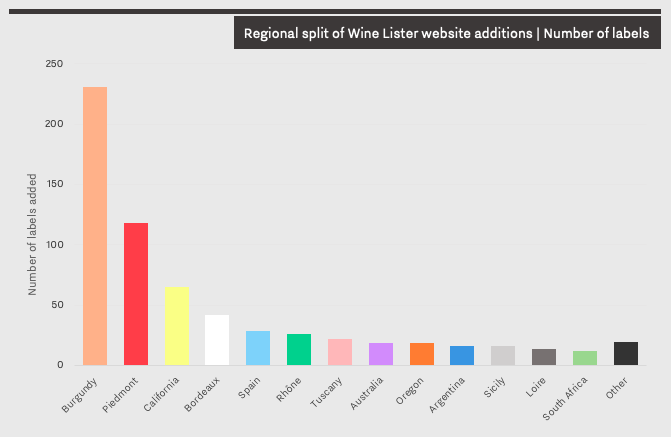
Burgundy represents 36% of the new selection, with more cuvées added from the likes of Pierre-Yves Colin-Morey, Cécile Tremblay, Benjamin Leroux, and more. A further 42 wines (6%) are added to the already-established set of Bordeaux properties featured on the Wine Lister site, including Cru Bourgeois Exceptionnels, Cambon La Pelouse, and Malescasse. Domaine des Roches Neuves represents seven out of the 10 new additions from the Rhône, alongside Bernard Baudry and Domaine du Closel.
Wine Lister’s Italian listings grow by 24% in the latest update, including 118 additions from Piedmont, 22 from Tuscany, and 16 from Sicily. The new Piedmontese picks include Arnaldo Rivera Barolo, Elvio Cogno, Figli Luigi Oddero, Giuseppe Mascarello e Figlio, and more. A region on the rise, Sicilian additions include new wines from organic Etna producers, Tenuta delle Terre Nere and Passopisciaro.
Wine Lister has also expanded its New World portfolio, which now features more additions from California (10% of the latest haul), Australia, and Oregon, among other regions. Featured amongst the new Californian picks are rising estates such as Littorai, Quintessa, Bevan, and Cardinale. Moving up the West Coast, Oregon additions include five new wines from Evening Land, four new bottles from Bergstrom, and three new picks from Antica Terra.
For more industry insights and advice on which wines and regions to buy, sign up for Wine Lister’s free newsletter here. Members of the trade can sign up to the Pro account to search and filter wines by Wine Lister Pro metrics.
Any of the producers recently added to the Wine Lister website can provide us with additional information on their wines, including production volumes, grape varieties, and label images. Email us at: team@wine-lister.com.
In Wine Lister’s latest Bordeaux Study, we examine a five-vintage retrospective analysis showing the greatest positive percentage change between wines at ex-négociant release price and current market prices.
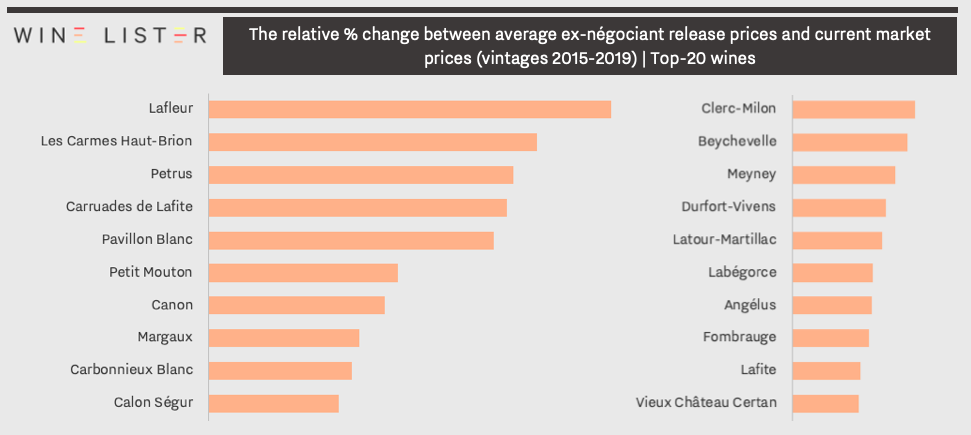 Top 20 by relative price change between average ex-négociant releases and current market
Top 20 by relative price change between average ex-négociant releases and current market
Which of the Bordeaux 2020 offerings show greatest price potential post-release?
One of the most significant periods of purchasing in a wine collector’s calendar is once again upon us. Bordeaux en primeur provides the opportunity to secure wines before they are bottled, with the primary benefits being both to gain access to crus that sell out quickly, and to pick them up at attractive prices, which will likely be higher once the wine becomes physically available.
Taking a closer look at the top-20 wines in the list, these bottles often see significant demand post- release, and are worth keeping an eye out for during the impending en primeur campaign.
Small-volume sensations
Lafleur, Les Carmes Haut-Brion, and Petrus typically see the greatest percentage changes in price, with all three producing notably small volumes within the context of Bordeaux – c.1,000, 1,800, and 2,500 cases per annum, respectively. With rarity on its side, demand for Lafleur has encouraged its original release price to grow by 115% on average in the secondary market.
Family of four
Four of the wines featured are produced under the same roof, or by the same team, as the Bordeaux First Growths, with demand surely heightened through association. Carruades de Lafite, Pavillon Blanc, Petit Mouton, and Clerc-Milon all offer potential price increase post-release, at a lower initial price than their Premier Cru siblings. Appearing fourth on the list, Carruades de Lafite has seen market price increase by c.56% post-release across the past five vintages, while the current cost of Petit Mouton is up c.54% on its ex-négociant price.
Rising through the ranks
Offering relative value and potential for future returns, several “rising stars” are featured in the ranking, and are worth watching over the upcoming releases. Canon, Calon Ségur, and trade darling for good value, Meyney have exhibited strong increases in quality over recent years, which has resulted in higher demand, and thus strong price performance after en primeur campaigns. The three promising picks have seen their average price increase by c.33%, c.24%, and c.19% respectively.
The full report can be purchased on our Analysis page, while Pro subscribers can access their free copy here. Wine Lister provides Pro+ subscribers with real-time en primeur release alerts during the campaign. Email us to enquire about signing up, or track releases prices on our dedicated en primeur page here.
As the fine wine industry starts preparing for another Bordeaux en primeur season at a distance, Wine Lister has published Part I of its annual in-depth Bordeaux Study. With insights from key fine wine trade players from across the globe, Part I evaluates Bordeaux’s recent performance, considers the major takeaways from the 2019 vintage campaign, and contemplates the lessons they might provide moving forwards.
Please see our key findings below:
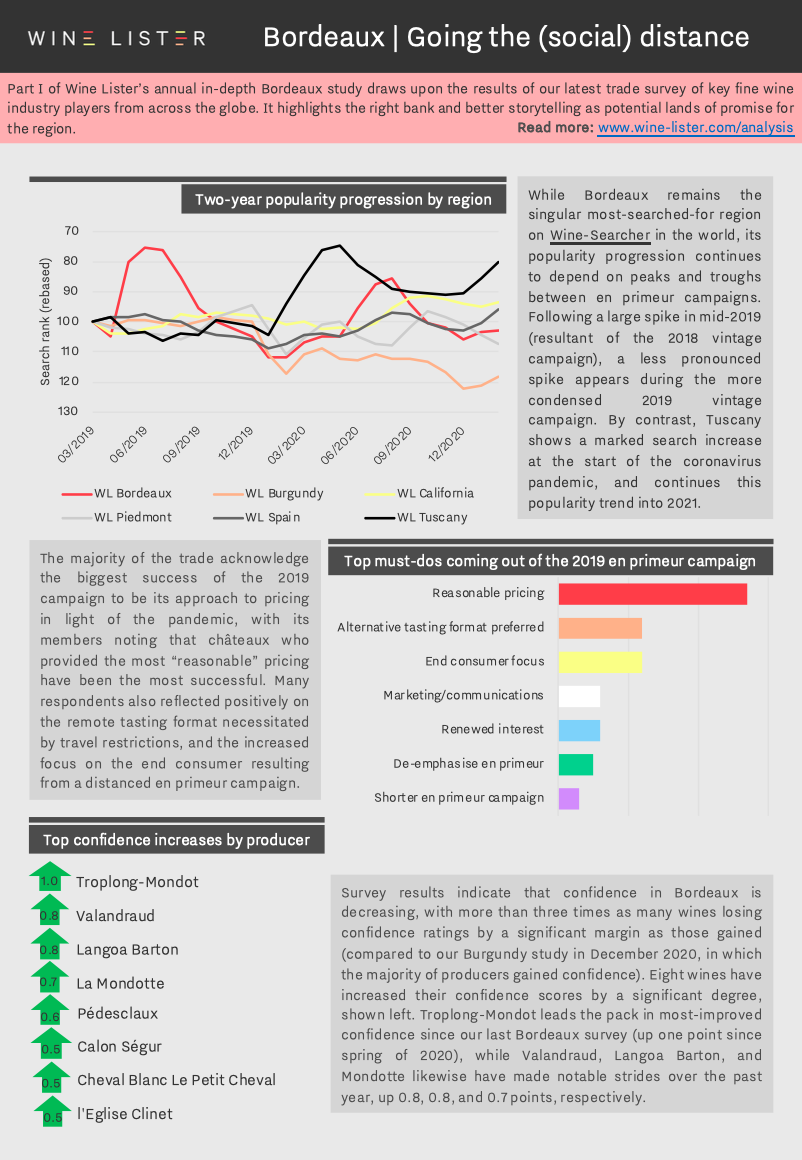
You can download the study digest in English here: Wine Lister 2021 Bordeaux Study – Digest or French here: Wine Lister 2021 Bordeaux Résumé d’étude. The full report can be purchased on our Analysis page, while Pro subscribers can access their free copy here.
With Bordeaux 2020 en primeur fast approaching, Wine Lister reports on one of the latest updates to emerge from the Médoc, informing your investment decisions over the coming months. In collaboration with Château Lafon-Rochet, we speak to Basile Tesseron to find out more about the inaugural partnership of two of the most revered consultants in Bordeaux to work on the estate’s 2020 blend: Jean-Claude Berrouet and Eric Boissenot.

Renowned for his expertise in Merlot production at Pomerol’s Château Petrus, Lafon-Rochet’s existing consultant, Jean-Claude Berrouet has been working at the estate alongside his son, Jeff, since 2012. Basile tells us that his team “admire the quality of the tannins present in the wines that Jean-Claude consults on, as well as his expertise with grapes coming from clay soils”.
With almost half of the estate based on clay, and the other half on dry, deep, gravely soils, he explains that “it was logical to combine Jean-Claude’s work with that of Eric Boissenot”, whose father, Jacques, has also been working with Lafon-Rochet for several years. With a reputation as oenologist to some of the Médoc’s top châteaux, Eric Boissenot is known for his dedication to the accentuation of terroir.
This meeting of minds from the Right and Left Banks for the first time illustrates another step in the evolution of Lafon-Rochet under Basile’s guidance. Since taking over the running of the estate in 2007, he has overseen the construction of two new cellars, extensive replanting, and a dedicated biodiversity programme. Having spent several years conducting agroforestry trials, last year Lafon-Rochet embarked on an agroforestry scheme that aims to make the estate wild once again through assisted natural regeneration. As well as installing bat nesting boxes and beehives, the property aims to plant 13,000 trees on its land by 2022.
Click here to sign up to Wine Lister’s free newsletter to keep track of everything en primeur over the coming months, including our recommendations on which releases to buy.
WL PR offers a dedicated communications service to help fine wine producers tell their story within the UK market. Head to our services page here to find out more.
With the bank holiday weekend approaching, Wine Lister has selected 10 mature Bordeaux MUST BUYs that promise to please with your Easter Sunday lunch. Boasting at least nine years of ageing, these top picks are available to purchase for under £100 (per bottle in-bond, when purchasing by the case in general).
Check out all of our Bordeaux MUST BUYs here, or read more below.
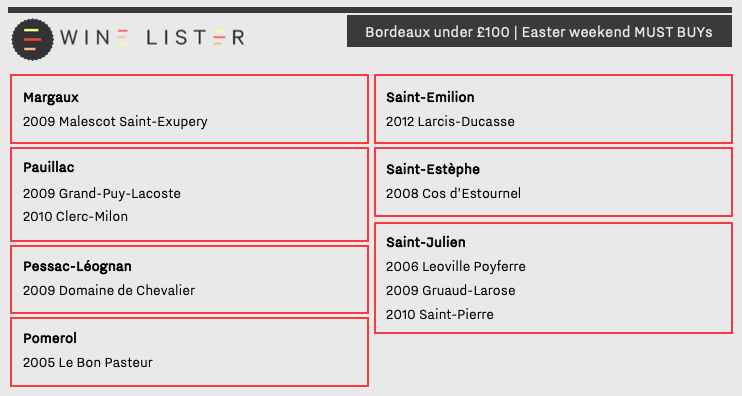
Regarded as a top-quality year for Bordeaux across appellations four of the 10 MUST BUY picks hail from 2009. Following a wet spring that provided plentiful water reserves, the summer of 2009 saw almost perfect growing conditions with minimal disease pressure, and many great wines from the vintage are beginning to either their optimum drinking window.
Described by Wine Lister partner critic, Jancis Robinson, as “very winning and opulent” with “massive volume and finish”, Margaux’s Malescot Saint-Exupery achieves a WL score of 93 in 2009. The property has exhibited an upward quality trajectory since the turn of the century, with the legendary Michel Rolland consulting on its production of a single, unfiltered and unfined wine. The 2009 vintage can be purchased from Fine+Rare for £71 per bottle (in-bond).
Grand-Puy-Lacoste’s 2009 vintage receives 18 points from Robinson, who notes; “a very sweet start. Herbal and interesting. Lots of fine tannin and savour. Very distinctive and ambitious”. Marking the estate’s highest WL score since its 1990 vintage (94), the 2009 is available to purchase from Bordeaux Index for £59 per bottle (in-bond).
Another classic left bank brand, Gruaud-Larose’s 2009 is described by Wine Lister partner critic, Neal Martin (Vinous), as offering refined aromas of “blackberry, cedar and leather”, and a “fine bead of acidity [with] great precision on the brown spice infused finish”. Hailed for the longevity of its wines, this can be enjoyed now, or aged for at least 10 more years. It is available from Bordeaux Index for £81 per bottle (in-bond).
Moving across to the right bank and back a few vintages, 2005 Le Bon Pasteur achieves the property’s highest ever WL score (94), and is described by Wine Lister partner critic, Bettane+Desseauve as offering notes of “dark fruits and fine chocolate”, and a “refined tannic structure, brilliant length and freshness”. With over 15 years of age, and only 2,500 bottles released, it has limited remaining market availability, but can be sought out for £100 per bottle (in-bond) from Cru World Wine.
Slightly south in Saint-Émilion, our chosen younger offering from Larcis-Ducasse – the 2012 – is available from Cult Wines for £41 per bottle (in-bond), making it the least expensive of the group. While rain in October forced many left bank estates to pick their late-ripening Cabernet Sauvignon earlier, the predominance of Merlot on the right bank saw its wines perform comparably better in 2012. Wine Lister partner critic, Jeannie Cho Lee, describes the 2012 Larcis-Ducasse as an “elegant, full bodied red with opulent tannins and wonderful energy”.
Last but not least, Saint-Estèphe star Cos d’Estournel makes the cut for its 2008 vintage. Robinson describes it as “very luscious and round” with a “strong blackcurrant element” and “surprisingly gentle tannins”. Achieving a WL score of 94, it is available to purchase by the bottle from Lay & Wheeler for £88 (in-bond).
To mark the first day of spring (Saturday 20th March), this week’s blog takes a deep dive into Wine Lister’s latest MUST BUY update, helping you to discover some excellent wines to enjoy over the next few months. The 19 new MUST BUYs cover a range of regions, varieties, and styles, providing inspiration for top picks to drink now or put away for the future.
Click here to view all MUST BUYs, or read more below.
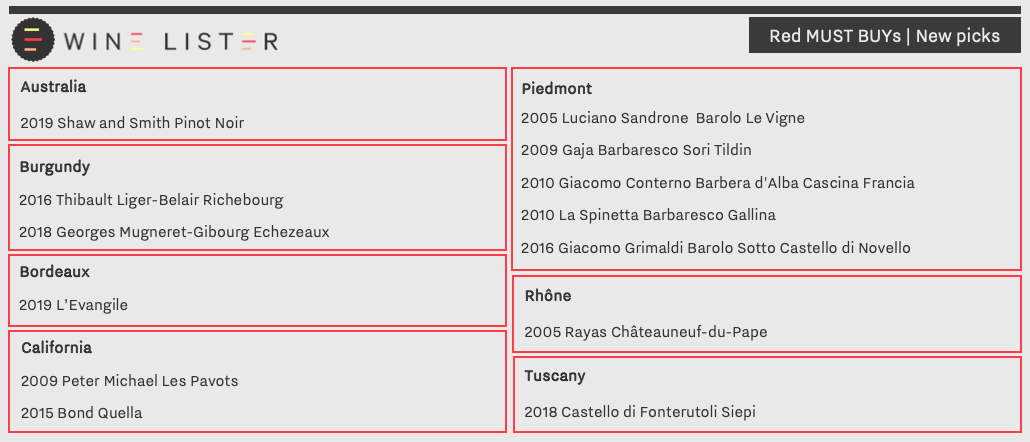
Piedmont constitutes over a quarter of the new MUST BUY picks, with entries from five of the region’s leading producers. Currently at its peak drinking, Luciano Sandrone’s 2005 Barolo Le Vigne comprises a blend of fruit from four of the estate’s top vineyards, each with different terroirs, altitudes, and exposures. Harvested, vinified, and aged separately, the final assemblage is intended to express the best characteristics of each plot. Wine Lister’s partner critic, Jancis Robinson, describes it as “complex”, with “already very integrated aromas”. It can be purchased from Farr Vintners for £79 per bottle (in-bond).
In Burgundy, Thibault Liger-Belair’s 2018 Richebourg achieves its highest WL score since the successful 2010 vintage (96), and is described by Wine Lister’s Burgundy specialist critic, Jasper Morris, as possibly “[Thibault’s] best Richebourg to date”. Awarding it 95-98 points, Jasper notes that “the oak […] is so suffused by a brilliant dense entirely red fruit, soft strawberry and more pronounced raspberry”. It is available to buy from Corney & Barrow for £450 per bottle (in-bond).
Representing the Southern Hemisphere, Shaw and Smith’s 2019 Pinot Noir also has Value Pick status, with a WL score of 92 at £26 per bottle (in-bond). The first vintage to include fruit from the property’s Lenswood vineyard, which boasts mature vines and high altitude, it marks an exciting development for Shaw and Smith. Richard Hemming for Jancis Robinson describes it at “superbly fragrant” and representative of “the sheer pleasure of the variety”. It can be bought from The Fine Wine Company.

Pierre-Yves Colin-Morey makes up two of three Burgundy whites to feature in the latest MUST BUY update, with its 2016 Meursault Perrières and 2018 Corton-Charlemagne. At £210 per bottle (in-bond), the former achieves 94 points from Jasper Morris, who notes “riper fruit, almost some orange blossom, but still an underlying freshness”. Meanwhile, Julia Harding for Jancis Robinson awards 19 points to the 2018 Corton-Charlemagne, describing it as “powerful and elegant” with a “smoky and quite subtle” nose. While both wines are more difficult to source, it is worth informing your merchant of your interest in purchasing them.
Other wines featured in the new MUST BUY selection are: 2005 Rayas Châteauneuf-du-Pape, 2009 Gaja Barbaresco Sori Tildin, 2009 Peter Michael Les Pavots, 2010 Giacomo Conterno Barbera d’Alba Cascina Francia, 2010 La Spinetta Barbaresco Gallina, 2014 Bouchard Père et Fils Montrachet, 2015 Bond Quella, 2016 Giacomo Grimaldi Barolo Sotto Castello di Novello, 2017 Gangloff Condrieu, 2017 Kistler Vineyards Hudson Vineyard Chardonnay, 2017 Kistler Vineyards McCrea Vineyard Chardonnay, 2018 Castello di Fonterutoli Siepi, 2018 Georges Mugneret-Gibourg Echezeaux, and 2019 l’Evangile.
Following a successful campaign for Brunello 2015s in 2020, this year’s releases of Brunello 2016 will surely take one of Italy’s prominent winemaking appellations to new heights. Below we take a closer look at a handful of Brunello producers to look out for, as the region as a whole continues to rise in fine wine spheres.
Il Poggione
With a family history dating back to the 1800s (and beginning with Lavinio Franceschi), Il Poggione’s multi-generational winemaking experiences have given its wines quite the reputation. As the number one most popular Brunello (as measured by Wine Lister’s search rank, based on monthly searches conducted on the world’s most-visited wine website, Wine-Searcher), is it most certainly deserved – indeed, for the 2016 vintage, Il Poggione achieves a Wine Lister score of 97 – it’s best ever. Writing for Vinous, Eric Guido names it “a classic in the making”.
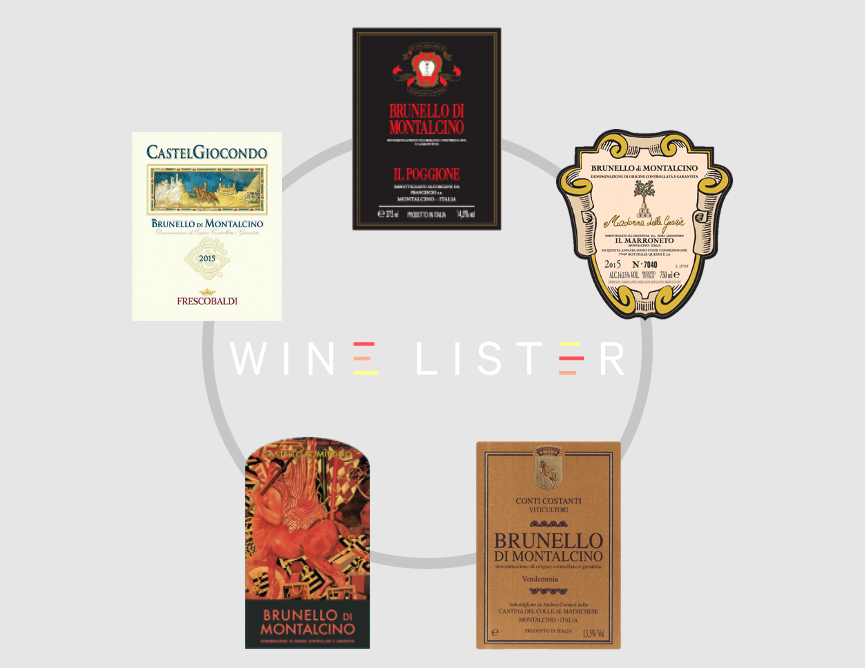
Il Marroneto
A comparatively young project, Il Marroneto was born from the purchase of vines by lawyer, Giuseppe Mori in 1974, and the ensuing passion for winemaking held by one of his sons, Alessandro. Strict commitment to quality has since seen the estate rise to become a quiet reference for the region, fetching high prices to match. Small availability from the latest vintage (2016) of the flagship wine, Madonna delle Grazie impressive is still available, at c.£263 per bottle in-bond).
Conti Costanti
Stemming from one of the most influential Sienese families of the 15th century, Costanti is another Brunello estate with wealthy history, and strong family traditions. As one of the first producers to present a wine under the name we know as “Brunello” today, its style has evolved beautifully under the watchful eye of winemaker, Andrea Costanti (indeed two recent vintages, the 2013 and 2010 achieve Wine Lister MUST BUY status). Awarding the 2015 vintage 17.5 points, Walter Speller writing for JancisRobinson.com notes, “True precision but definitely ‘sexy’ and sheer pleasure”.
Castello di Romitorio
Romitorio’s impressive castle possesses a rich history dating back to the Etruscans, while both its interior and the vines it overlooks benefit from the modern influence of its current ownership. Purchased by artist, Sandro Chia in 1984, his son, Filippo now runs the estate and makes its wine. Having attended a virtual tasting with him recently, organised by Honest Grapes, the wines appear to reflect their estate’s history in their timelessness, balancing a traditional style with contemporary energy and elegance. Some availability of the 2016 Brunello di Montalcino and single-vineyard offering, Filo di Seta, remains.
Castelgiocondo
A few kilometres southwest, lies “the castle of Giocondo” – another imposing Tuscan structure, originally constructed in the 12th century (AD) to guard the road leading from Siena to the sea, and owned since by one of the most famous families in Tuscany – the Frescobaldis. Joining Il Poggione’s Franceschi family in being one of the very first to produce Brunello in the 1800s, Castelgiocondo’s straight Brunello offering is also among the top-ranking wines of its kind in popularity. Those wishing to snap up the latest vintage offering may need to give it some time – writing for Vinous, Antonio Galloni notes the 2016 “needs some time to come together […] yet it has all the balance necessary to mature into a real beauty”.
Explore more top-scoring Brunello here.
Having commenced the week with International Women’s Day (Monday 8th March), Wine Lister’s latest blog celebrates some of the leading female figures in winemaking. Interviewing a handful of top producers across six regions, whose practices embody a range of principals, we put a spotlight on the wines made by some of the industry’s most exceptional women.
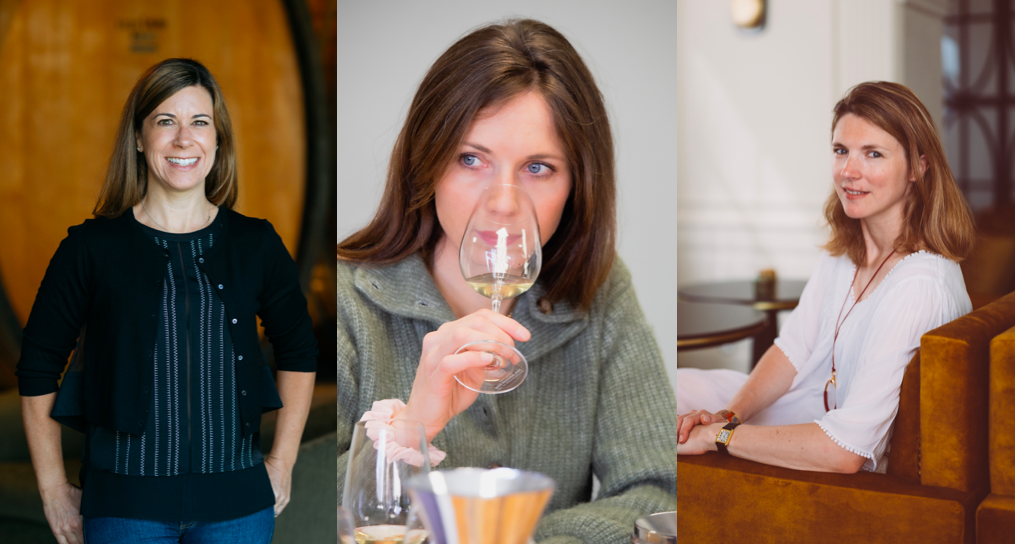 From left: Ashley Hepworth, Caroline Frey, and Stéphanie de Boüard-Rivoal
From left: Ashley Hepworth, Caroline Frey, and Stéphanie de Boüard-Rivoal
Ashley Hepworth – Joseph Phelps Vineyards
Following a degree in Chemistry and Biology, Ashley Hepworth spent two years cooking at Charlie Trotter’s legendary Chicago restaurant, where she realised she “wanted to learn more about wine and utilize [her] science background”. After studying the restaurant’s wines, and quizzing its Master Sommeliers, she applied for a harvest internship at Joseph Phelps where she continued to work her way “up the ladder”, eventually becoming winemaker in 2008. She is “particularly fond” of the 2008, 2015, and 2017 vintages of Joseph Phelps’ flagship wine, Insignia, explaining that each are “distinctive of the given vintage and the interplay of the six estate vineyards” that the wine is blended from.
Caroline Frey – La Lagune and Paul Jaboulet Aîné
Having taken the helm of third-growth property La Lagune from her father in 2004, Caroline Frey has since assumed an additional winemaking role in the Rhône, at Paul Jaboulet Aîné, after its acquisition by her family in 2005. Like several of the producers we spoke to, Caroline informs us that working “in harmony with nature is a long-term project” for her, with both properties now certified biodynamic. She explains that “to produce great wine the grapes must be the fruit of nature and not of synthetic chemistry”, and the more she “improves in working in harmony with nature” the “more wonderful” her wine will be.
Stéphanie de Boüard-Rivoal – Angélus
Having spent her childhood at Angélus, Stéphanie de Boüard-Rivoal was seven years old when she told her grandfather, Jacques de Boüard de Laforest, that she wanted to join him and her father, Hubert, in running the estate. After an early career in London’s financial sector, Stéphanie returned to Angélus in 2012, and has since continued a “quest for excellence while endeavouring to keep the estate in [her] family”. Noting “purity, tension, and focus” as key words to describe the style of her wine, she tells us that she is currently fond of Angélus’ 2005 and 2010 vintages, and anticipates enjoyment of the 2016 and 2018 in the coming years.
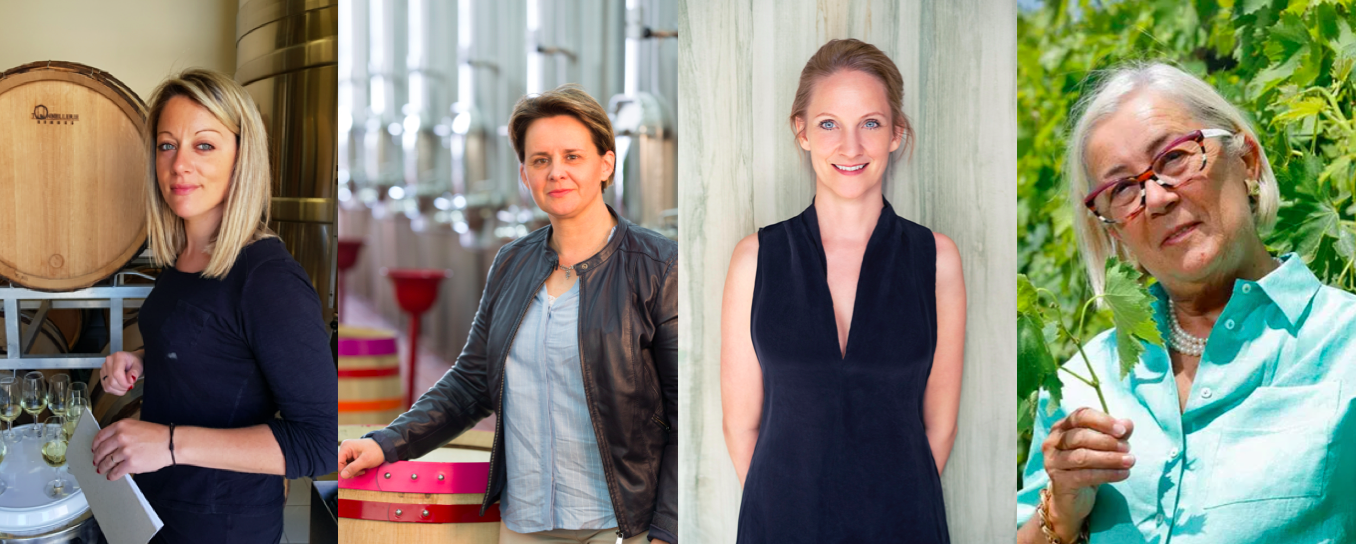 From left: Charlène Pinson, Florence Heresztyn-Mazzini, Eva Fricke, and Donatella Cinelli Colombini
From left: Charlène Pinson, Florence Heresztyn-Mazzini, Eva Fricke, and Donatella Cinelli Colombini
Charlène Pinson – Pinson
One of the longest-established families in Chablis, records show that the Pinsons have been producing in the region since 1640. Having joined her father, Laurent, at the estate in 2008, Charlène Pinson tells us of her respect for tradition and the work that her family has done before her, with the aim to “pass on the passion” to her two sons. Producing 13 different wines, she explains that each is a “reflection of their terroirs”, and are “more or less floral and fruity” depending on the slope and soil of the parcel. For those new to Pinson, she recommends the 2017 Chablis Mont de Milieu, describing it as a “pure expression of our Kimmeridgian limestones […] classic, mineral, balanced, and fresh”.
Florence Heresztyn-Mazzini – Heresztyn-Mazzini
Taking over her family’s estate (Domaine Heresztyn) in 2012, Florence Heresztyn-Mazzini and her husband, Simon Mazzini have overseen numerous developments under its new name. Introducing biodynamic practices in 2015, and achieving organic certification in 2019, Florence continues to “experiment with natural treatments” to fulfil her goal of “fighting the challenges of climate change”, including more “cover crops and sustainable pruning”. Explaining that many recent vintages have been difficult due to global warming, she tells us that she is particularly proud of her “fights” in 2013 and 2016, creating top quality wines in years that “remind us that we are small in the face of Mother Nature!”.
Eva Fricke – Eva Fricke
After making wine in Australia, Spain, and Germany, Eva Fricke returned to Germany in 2006 to start her own estate, which now holds 17ha across the Rheingau. Achieving organic certification in 2016 and membership in The Vegan Society in 2017, the property also employs several biodynamic practices including its adherence to the lunar calendar. She tells us that these principals guide her goals of developing a domain that “stands for organic, sustainable, and socially conscious standards”. Eva notes the “2019 Lorcher Schlossberg, 2019 Lorcher Krone Trocken, and 2019 Lorcher Krone Trockenbeerenauslese” as some of her top wines.
Donatella Cinelli Colombini – Casato Prime Donne and Fattoria del Colle
Born into a family of winemakers whose production in Montalcino can be traced back to 1592, Donatella Cinelli Colombini tells that it is “for this reason” that winemaking comes naturally to her. Founding Italy’s first winery run solely by women, she explains that her decision to have an all-female staff at Casato Prime Donne “leaves an imprint of acute accuracy in each step of the production process”. She notes of Casato Prime Donne wines that they are some of the first “chosen, and produced by women, for women”.

 Left: Baptise Guinaudeau of Lafleur and Grand Village / Right: Véronique Sanders of Haut-Bailly and Le Pape
Left: Baptise Guinaudeau of Lafleur and Grand Village / Right: Véronique Sanders of Haut-Bailly and Le Pape








